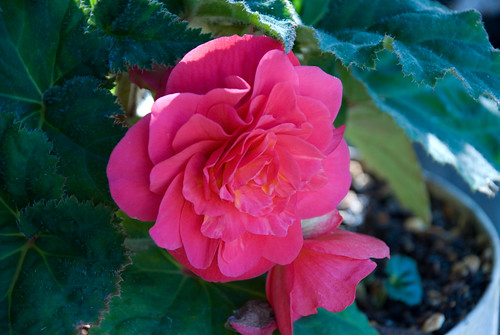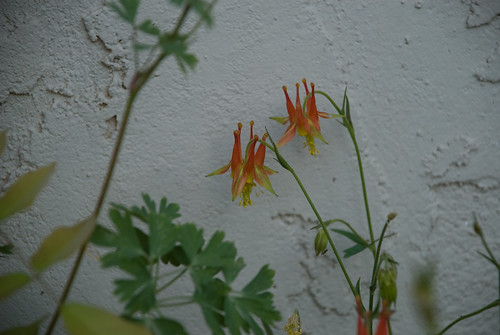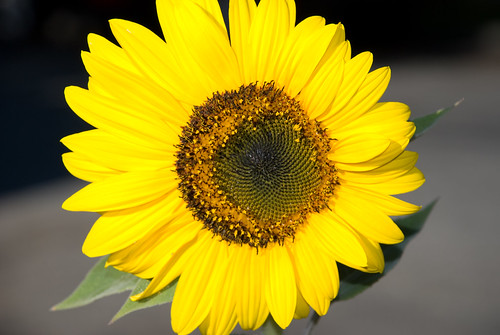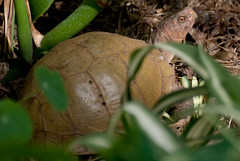Today I'm going to take a different approach, something hopefully a bit simpler and shorter than last time. Tell me what you think.
The following are flowering in my yard as of today:
- Tuberous Begonia - I bought this "annual" eleven or twelve years ago and it's still going strong.

- Western Columbine -
 A few days ago I was worried that I wouldn't have an decent-looking blossoms of this California Native to show today, but they proved me wrong!
A few days ago I was worried that I wouldn't have an decent-looking blossoms of this California Native to show today, but they proved me wrong! - Coral Bells - This non-native (tho' closely related to our native Heuchera species) is fading fast on me. Actually, I'm surprised they've lasted this long in the recent heat wave.
- Nasturtium - Also non-native and also getting pretty ratty... um... fading fast. The hummingbirds still give them a good working over.
- Canna Lilies - Again, non-native, but they make really inviting red flowers for the hummingbirds.
- Lobelia - Again, non-native, this lobelia is a volunteer of unknown pedigree, but it makes for a pretty, lacy, blue-and-white contrast to the broad leaved, yellow flowered Seep Monkeyflower below.
- Seep Monkeyflower - This California native has really found a happy home under the bird bath.
- Western Virgin's Bower - This California native vine is working hard at completely taking over the the fences in the back corner of my lot... and the roof of the pool house behind me.
- Love in a Mist - Non-native wildflower that is trying to take over the yard. At first it was cute -- mostly because it looks so alien -- but now it's getting a tad invasive. I'll be working at removing it for a while.
- Hollyhocks - Another volunteer, non-native, traditional European flower.
- Chrysanthemum - I planted these (non-natives) one fall ten or eleven years ago, supposedly as annual fall color. It's still hanging on. And blooming in non-fall timeframes.
- Calendula - Again, I planted a few seeds one fall ten or eleven years ago. This one re-seeds itself quite freely. This is another plant that I will need to start pulling early and often to be rid of it.
- Various Roses - I have a climbing red rose; an unknown, cream with pink unknown florabunda; and a single old-fashioned rose that's covered in thorns. Two weeks ago they were all covered in lush blooms. With the heat wave, they're mostly looking sad, but they are also all putting on new buds.
- Fibrous Begonia - This was a bedding plant that I put in the first spring I was in this house back in 1998. Most people have to replace these every year because they mostly die off over the winter. Not this guy!
- Parsley - Not native, not on the "oooh!" chart for blooms, but like all of its relatives, it attracts lots of insects that the birdies like.
- Redwood Sorrel - Our native oxalis! Yes, it's related to the yellow, sour-grass, Bermuda Sorrel that covers the hills in the spring, but it's not nearly as invasive and has much more interesting foliage. Plus, the flowers are a pretty pink.
- Impatiens - I planted one. I swear. And this Jamaican native is supposed to behave like a native here and is supposed to be sterile, but no......
- Geraniums - I have some Ivy Geraniums hanging in pots on the deck and a pink geranium in the ground.
- White-Flowered Vine (Solanum rattonii?) - This thing is almost always in bloom. Not native.
- Clarkia, Farewell to Spring - Now that it's summer, this native Clarkia is, indeed, bidding a farewell to spring. These are the last of the blooms.
- Sticky Monkeyflower - I'm beginning to think that this native monkeyflower is also a perpetual bloomer.
- Blue Elderberry - This native elderberry tree has massive hands of ripening berries, yet it insists on continuing to put on new blossoms.
- Cucumber - Not native, but tasty! I have planted cucumbers along the south-facing garage wall to climb a trellis. Given the number of blossoms, I'm going to have to be making a lot of cucumber salads, cucumber soups, cucumber...
- Rosy Buckwheat - This little native is so pretty that I wish it would do better at getting big, spreading out, putting on more flowers, ...
- (Sulfur Buckwheat) - Psych! It's not actually putting on new flowers. This native puts on light yellow flowers that slowly fade to browns to a very nice effect.
- Plumbago (vining and creeping) - Neither are native, but they put on pretty blue flowers and they came with the house.
- California Poppies (second or third flush)
- Sunflowers

- Miscellaneous DYCs (Damned Yellow Composites), aka "Weeds"










I like seeing the flowers, but the links to each one work ok, too. Whatever's easier for you! And thanks for the link to that other post--it identified one of my flowers that I just photographed that I labeled "large purple". :-)
ReplyDeleteI think the links are easier. I don't even have to drop into the HTML editor to do those cuz there's a UI for the links. The list still ended up being stupendously long. Gotta think of something more terse. But I wanted to include a handful of the prettier or more interesting blooms, too.
ReplyDeleteYou're welcome for the link! Glad to be of assistance. But don't you label at least half of your flowers "[something] purple"? :-)